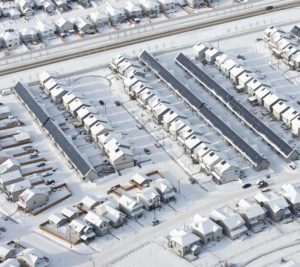
Drake Landing provides a real-world example of how conventional heating fuel consumption for space heating can be nearly eliminated, reducing greenhouse gas emissions by more than 5.5 tons per house annually. This is made possible in the harsh 9,027 heating degree day climate by using solar heat collectors with seasonal heat storage, energy-efficient house design and construction, and a low temperature district heating network to distribute the heat to the homes.
The system has been monitored in detail to document its performance and to refine the model used in its design since being brought into service in July 2007. Refinements have included adjustments to the design assumptions for borehole thermal energy storage soil properties, shortterm thermal storage stratification and heat loss and pumping energy.
Besides controlling the system, the automated control system also is used to record over 100 temperatures,
flow rates, pressures and other operating parameters every 10 minutes. These data combined with monthly readings from utility meters and the high accuracy heat meters that are installed in each house provide a comprehensive picture of system operation and energy flows.
In year six, a total of 2,308 million Btu (MBtu), or 98%, of the heat delivered by the district loop was from solar and the remaining 2%, (40 MBtu), was from natural gas. Purchased electricity to operate the pumps, fans, lights and controls, was 68 MBtu, and 21 MBtu of site generated electricity was exported to the grid.
Domestic consumption in the 52 homes for all uses was 1,098 MBtu in natural gas and 1,408 MBtu in electricity (extrapolated based on electricity use data for 29 houses). The resulting annual net site energy use intensity was 20.7 kBtu/ft2 for all site energy uses.
As a result of the large solar contribution, the annual net site energy use intensity for space heating was 0.87 kBtu/ft2. When all household energy consumption is included, the total site energy intensity is 42.8 kBtu/ft2 (renewable + conventional energy). For competing homes (those that use no renewable energy), the corresponding total site energy intensity is estimated to be 59 kBtu/ft2.